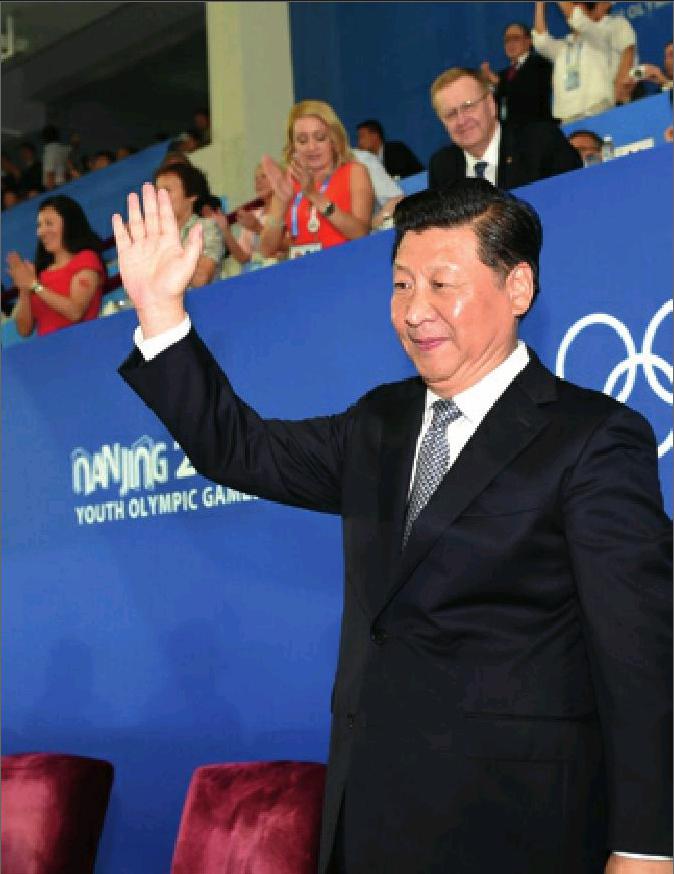Going For Gold
2014-09-23ByJiJing
By+Ji+Jing

dou Zecheng swings his arms in a delicate arc up and backward. Swinging his club back down, the small white ball atop his tee careens into the distance at the Zhongshan International Golf Club in Nanjing on August 15. The 17-year-old, who hails from central Chinas Henan Province, is the top-ranked Chinese amateur golfer, coming in at No. 39 in the World Amateur Golf Rankings. He is at the club training for the second-ever Youth Olympic Games in Nanjing.
Dou is lucky to have the opportunity to compete in this years Youth Olympics: Golf has been introduced to the Youth Olympics for the first time this year, along with rugby. In order to be able to compete at his highest level in the Games, Dou gave up participating in a major competition in July to focus on training.
“I feel honored to be the only golf player representing China. I feel the pressure, but I can handle it. My goal is to enjoy the fun of the competition while trying to win medals,” he said.
Introducing new sports represents just one of the many innovations of the Nanjing Youth Olympics. New features were included throughout the preparation and competitions of this years Games.
Compared with the 118-year history of the Olympic Games, the Youth Olympics is still in the preliminary stages of its development. Singapore made the idea a reality four years ago, while Nanjing has assumed the mission of making the event better-rounded. In order to do so, the Nanjing Youth Olympic Games Organizing Committee (NYOGOC) has taken a series of measures to develop and expand the event.
Innovative approaches
New to the Youth Olympics is the Sports Lab, located in the Yuzui Wetland Park, which opened to the public for free on August 17.
Established by the proposal of International Olympic Committee (IOC) President Thomas Bach, the lab aims to showcase non-Olympic sports such as martial arts, rock climbing, roller skating and skateboarding. During the Games, top athletes from around the world will display their skills at the lab.
“All four sports at the lab have unique characteristics and a wide number of participants,”said Wang Xiqiu, Executive Director of the Sports Lab. “For example, rock climbing—one of the basic skills required for mountain climbing—is an exciting challenge for young people and is gaining popularity around the world, while martial arts are typically Chinese and combine competition with physical exercise.”
Co-ed and mixed-nationality contests in 15 of the Games 28 sports represent another innovation this year. For example, in the 8x100-meter relay, 680 specialized track and field athletes of both genders and all nationalities will be randomly divided into 68 groups of 10 to take part in this competition.endprint
Cheng Yuyang, chief referee of the track and field events at the Youth Olympics, said this giant relay involving all track and field athletes was created to allow athletes specializing in events such as the long jump, javelin throwing and shot-put to enjoy an afternoon of carefree, short-distance running.
“Most importantly, as athletes represent themselves rather than their countries in the allnationalities competition, they are freed from the pressure of trying for gold and are able to enjoy the simple pleasure of sports,” said Lin Feng, Director of the Sports Management Department of the NYOGOC.
“Additionally, mixed competition is better than a traditional one in nurturing athletesteamwork skills, because participants dont know each other beforehand and need to cooperate closely in order to win,” Lin said.
Green games
Innovation applies not only to sports settings during the event, but also to the preparation for the Games. Frugality has been a focal point put forth by the organizing committee amidst the countrys call to host less costly events and the IOCs push to reduce the commercialization of sporting events.
“We have upheld frugality as the basic principle guiding our preparations,” Nanjing Mayor Miao Ruilin said on July 5.
The First Summer Youth Olympics, held in Singapore in 2010, cost an equivalent of 2 billion yuan ($325.2 million). The NYOGOC has made clear that the total expenditure will be 10-percent less than that of the Singapore Games, or no more than 1.8 billion yuan ($292.7 million). Striking a balance between hosting an Olympic-level event on a limited budget and enabling citizens to benefit from local investments afterward is a central concern of the organizing committee.
The 35 stadiums used for this years Youth Olympic Games were all converted from existing buildings. For example, the citys International Expo Center was originally used for exhibitions. During the Youth Olympics, its two halls will host boxing, taekwondo and fencing competitions, along with the fencing portion of the modern pentathlon. All the seats and stands have been rented and set up for temporary use. When the Games are over, these installments will be removed and the stadium will return to its role as an exhibition center.
The only brand-new venue built for the Games is the Youth Olympics Sports Park. Scheduled to open to the public after the Games, the park will function as an outdoor fitness center. “Even if we were not hosting the Games, we would have still built this park,” said Miao.endprint
The torch relay, an important component of the Games that served to spread the Olympic spirit while introducing Nanjing to the world, was also tweaked with an innovative approach: A“virtual torch relay” app was used to pass on the torch online. With the exception of the lighting of the torch in Athens, Greece, and the arrival of the torch in Nanjing, all other segments of the torch relay took place on the Internet through the app. Web users could download it and register to be a torch-bearer.
“The online torch relay enabled more people to be involved in the activity and allowed the torch to reach places that otherwise would be impossible,” said Zhang Le, an assistant spokesperson for the Cultural and Educational Section of the NYOGOC.
“The online torch relay has reduced costs, and really represented the concept of ‘greenYouth Olympics,” added Zhang.
Also, in order to improve the citys ecological environment and fulfill the promise of“green” and eco-friendly Olympics, the Nanjing Municipal Government has made efforts to improve the public transportation system. For example, the citys subways and light rails have reached 180 km, ranking Nanjings public transportation access high among cities of a similar scale. All the stadiums hosting competitions in the Games can be reached by means of public transportation, including buses and subways.
A chance to learn
The Youth Olympics is not only a sporting event, but includes a Culture and Education Program. The program, originally proposed by the IOC, is designed to encourage young athletes to develop skills and interests outside sports from an early age. Over 20 culture and education activities featuring skills development, healthy lifestyle education, social responsibility and selfexpression will take place in venues such as the Youth Olympic village, the Nanjing Laoshan Forest Park and the Nanjing Olympic Museum.
“A lot of athletes stop their [athletic] careers for different reasons, but its important for them to know there are other things in life. Even if you cant be a top athlete, life isnt over. You can always participate as a judge, a coach or a referee,” said Gilbert Felli, IOC Executive Director for the Olympic Games.
The education program, which includes talks with Olympic champions, will provide young athletes with a chance to communicate with sports stars and learn what they can do after retiring from competition.endprint
Galo Chiriboga Granja, an equestrian athlete from Ecuador, showed a deep interest in cul- tural activities in the Youth Olympic village. She learned some traditional Chinese dances upon arriving at the Youth Olympic village on August 11, and said she hoped to take the cooking class to learn how to make local Nanjing dishes.
“I have never been to an Olympic village before. Its fantastic. I cant believe that Im here,” Granja said.
To ensure that athletes have enough time to participate in these cultural and educational activities, the IOC requires single-sport federations to take two days off on their event schedules and encourages athletes to stay in Nanjing until the end of the games.
Qin Jinjing, an 18-year-old Chinese badminton player, said the Youth Olympics offers her a chance to learn and make international friends.
“The atmosphere here is more fun and relaxed than at other major events,” Qin said.“We have time to explore what is offered in the village and socialize with teenagers from other countries.”endprint
